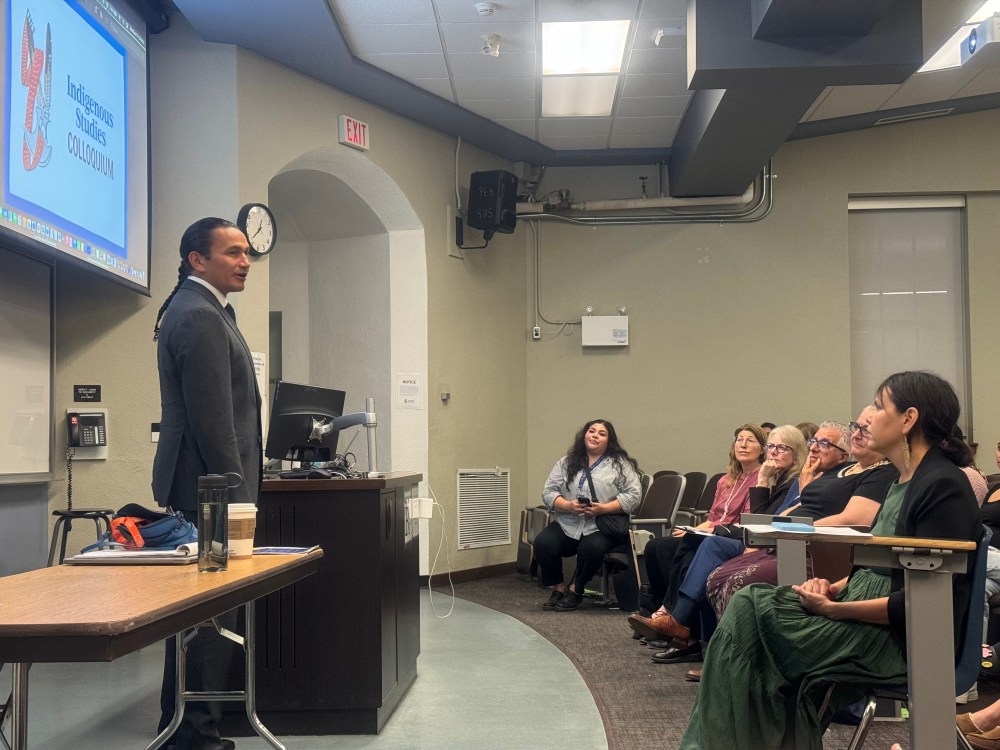Premier Wab Kinew took the unprecedented step of appointing himself the minister responsible for Indigenous reconciliation when his government was sworn in last year.
At the time, Kinew said he did it to show a “level of seriousness” between his government and First Nations and Métis governments in Manitoba – what he called a “nation-to-nation” relationship.
“The message that I am sending is simple and it is to the leaders of Indigenous governments across Manitoba,” Kinew announced. “Our government will recognize you for what you are – the leaders of governments. Governments just like the other orders of government within Manitoba, Canada and across North America.”

NIIGAAN SINCLAIR / FREE PRESS
Premier Wab Kinew speaks to Indigenous Studies students Wednesday at the University of Manitoba.
Saying this is one thing; doing it is quite another.
Kinew’s not the first to promise Indigenous leaders a “nation-to-nation” relationship. Almost every Canadian politician in the modern era has used this phrase with as much regularity as ignoring what it means.
To put it simply, the problem is that Canada’s constitution, laws, and structures of governance leave little room for First Nations and Métis to occupy much more than subservient forms of government, even if Indigenous leaders say otherwise.
The primary reason is Canadian authorities set the rules for who can be Indigenous governments, they dictate to those governments what they can or cannot do, and Indigenous communities have to fight all the way to the Supreme Court to have nearly every law, right or land claim recognized.
If an Indigenous community resists and, for example, institutes its own self-determined government and announces what it has jurisdiction over, this institution is denied, ignored or manipulated in favour of a model favoured by Canadian authorities.
In other words, Kinew’s “nation-to-nation” promise should reside in the same rhetorical pile with those made by prime ministers, premiers and mayors.
Only, his promise has resulted in several significant, tangible provincial initiatives working with First Nations and Métis governments.
In February, Kinew’s government announced an agreement to create a silica sand extraction project in Hollow Water First Nation and hundreds of new jobs in Selkirk – the former homelands of Peguis First Nation.
In May, Kinew’s government signed a declaration committing to the transfer of jurisdiction over child welfare to First Nations governments in Manitoba.
In July, Kinew’s government signed a memorandum of understanding with the Manitoba Métis Federation to transfer approximately 100 acres of the former community of Ste. Madeleine back to the Métis.
There’s the Search the Landfill project, the 20-year commitment to continue forestry and maintain jobs for three First Nations in the Swan Valley region, and the recognition of Louis Riel as Manitoba’s honorary first premier.
I could go on.
Some might think Kinew’s success is because he is Indigenous but it’s far more than that. In a presentation Wednesday to Indigenous studies students at the University of Manitoba, Kinew explained how he has overhauled the Manitoba Indigenous Reconciliation Secretariat and how the provincial department now works with First Nations and Métis governments.
“Manitoba now follows four guiding principles when working with First Nations and Métis governments and developing policy,” Kinew explained. “Language, land, culture, people – all four now guide the ways we work with Indigenous governments.”
It should surprise no one that Indigenous nations are driven by saving their traditional languages and receiving land back — but hearing a province dedicated to the same principles has opened up significant dialogue on Indigenous language immersion schools (similar to French) and potential lithium, cobalt, and nickel development in the north — conversations First Nations have resisted with past provincial governments.
These two developments alone have started to shift the way education and resource development operates in Manitoba but the last two principles are radically changing the ways the provincial government interacts with Indigenous governments.
“Instead of us telling First Nations and Métis leaders how their cultures work and what their people want and need,” Kinew explained, “we take from the outset that Indigenous governments identify how they wish to be identified and therefore what best serves their people and Manitobans at the same time.”
Kinew says this has allowed cultural nations like the five Dakota communities in Manitoba or the 20 Anisininew communities in Manitoba and Ontario to be recognized not as individual First Nations but as self-determining nations.
First Nations leaders have long decried divide-and-conquer strategies that pit reserve governments against one another (resulting in the creation of regional unity organizations like the Southern Chiefs Organization) but now the government of Manitoba is telling Indigenous governments: “You tell us how you want to negotiate first.”
The Métis federation, as a government of nearly 200 Métis local governments across Manitoba, is perhaps best set up for this change — which explains why Kinew’s change in departmental delivery has resulted in early successes in the Manitoba-Métis federation relationship.
This new “nation-to-nation” relationship not only makes economic sense but fulfils Kinew’s personal goal to ensure “every Manitoban reaches the age of 18.”
A future built by all Manitobans, on their own terms — what an idea.
niigaan.sinclair@freepress.mb.ca

Niigaan Sinclair
Columnist
Niigaan Sinclair is Anishinaabe and is a columnist at the Winnipeg Free Press.
Our newsroom depends on a growing audience of readers to power our journalism. If you are not a paid reader, please consider becoming a subscriber.
Our newsroom depends on its audience of readers to power our journalism. Thank you for your support.